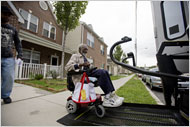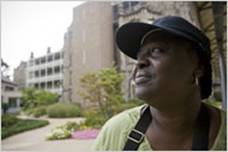|
Helping Elderly Leave Nursing Homes for a Home
By John Leland, www.nytimes.com
September 18, 2009

Jessica Kourkounis for The New York Times: Walter Brown was moved into public housing after having spent two years in a nursing home
Walter Brown never wanted to live in a nursing home, but when he had a stroke two years ago, he saw little choice. Mr. Brown, 72, could not walk, use his left arm or transfer himself into his wheelchair.
“It was like being in jail,” Mr. Brown said on a recent afternoon. “In the nursing home you’ve got to do what they say when they say it, go to bed when they tell you, eat what they want you to eat. The food was terrible.”
But recently state workers helped Mr. Brown find a two-bedroom apartment in public housing here, which he shares with his daughter. “It just makes me more relaxed, more confident in myself,” he said, speaking with some difficulty, but with a broad smile. “More confident in the future.”
A growing number of states are reaching out to people like Mr. Brown, who have been in nursing homes for more than six months, aiming to disprove the notion that once people have settled into a nursing home, they will be there forever. Since 2007, Medicaid has teamed up with 29 states to finance such programs, enabling the low-income elderly and people with disabilities to receive many services in their own homes.
The program in Pennsylvania provides up to $4,000 in moving expenses, including a furniture allowance and modifications to the apartment, and Mr. Brown has a home health aide every morning and a care manager to arrange for services like physical therapy. The new programs, financed largely by $1.75 billion from Medicaid, are a sharp departure from past practices, where Medicaid practically steered people into nursing homes.
“Medicaid has had an institutional bias in favor of nursing homes,” even for people who do not need them, said Gene Coffey, a staff lawyer at the nonprofit National Senior Citizens Law Center. “Federal law requires states to provide nursing home services. They don’t have to provide home or community-based services.”
For Mr. Brown, the transition to his own home has changed his life, he said. Now, with his motorized wheelchair, he travels the city on public buses, visiting friends in other neighborhoods.
“It’s a great feeling,” he said. “In the nursing home I got up at 5 o’clock in the morning, then the rest of the day was just watching the TV or my VCR. I wanted to be able to get out and see people, see the world. I didn’t want to be confined. Now I go where I want to go.”

Walter Brown said that after a while, being in a nursing home “was like being in jail.” Now, he is “more confident in the future.”
States and the federal government hope to save money, though research about cost savings has so far been inconclusive. A recent study by researchers at the University of California, San Francisco, found that home care costs taxpayers $44,000 a year less than a nursing home stay — though this number cannot be used to estimate total savings, because often home-based services replace family care, not nursing home care.
About 1.5 million Americans are living in nursing homes.
“It’s amazing how quickly people can end up in a nursing home,” said Jean Janik, the director of community living options at the nonprofit Philadelphia Corporation for Aging. “Say you’re a single man and have a stroke, and need to go into a nursing home to rehab. You’re elderly so you don’t quite bounce back quickly. After 60 days, Medicare doesn’t pay any longer, so you need a Medicaid grant to stay in the nursing home. Then your Social Security will go to the nursing home.”
Many lose their apartments and regular support from family members, Ms. Janik said.
“We meet people who say, ‘I went to the hospital and next thing I know, here I am. I don’t know what happened to my apartment.’ ” Ms. Janik added, “We go and check, and it’s not in their name. Especially if they don’t have a strong family support system in place. A lot of people just think, Uncle Joe fell and broke his hip and now he’s in a nursing home, so be it, that’s where he’ll be. People don’t realize they can get services in their home.”
Each participating state has designed its own program, called Money Follows the Person. The federal government, which shares Medicaid costs, provides extra financing for the first year.
Some experts worry that the programs will end up transferring some of the expenses of caring for the elderly or the disabled to their family members.
Carol Irvin, a senior researcher at Mathematica Policy Research has been contracted by Medicare and Medicaid Services to study the costs of the program in its first five years.
“It could be shifting costs onto a person’s relatives,” Ms. Irvin said. “But even if it’s not saving money, a lot of people believe living in the community is the right thing for individuals.”
Elizabeth Kamara, 72, spent 18 months in a nursing home after having her left foot amputated because of diabetes. Mrs. Kamara can get around using a walker, but in the nursing home she spent whole days in a wheelchair.
“I just let people do things for me,” she said. “They say, ‘If you fall, we’ll get in trouble. Please sit down.’ ”

Elizabeth Kamara was in a nursing home, but says of her apartment, “This is my home; I’m free.”
Mrs. Kamara has moved into a independent living facility, where she cooks dishes from her native Sierra Leone and navigates the hallways on her own. She gives herself insulin injections and gets a friend to drive her to doctors’ appointments. An aide comes twice a week to help clean. “This is my home; I’m free,” she said. “In the nursing home it was two persons in one room. Here I have my privacy. I can get my hair done, my nails done.”
Susan C. Reinhard, a senior vice president of the AARP Public Policy Institute, said of Money Follows the Person: “It’s gotten Congress’s attention, and shown that people can leave a nursing home. That is a wake-up.”
For Esther Pinckney, 88, who ended up in a nursing home after a stroke, moving out has been literally a breath of fresh air. Ms. Pinckney now lives in a bright subsidized apartment where home aides visit twice a day.
“What didn’t I like about the nursing home?” she asked recently. “What would you like about smell, smell, smell, morning, noon and night?”
Because Ms. Pinckney lost her apartment and furniture while she was in the nursing home, the Philadelphia Corporation for Aging bought her new furniture and a microwave oven. Before, she said, her Social Security check went to the nursing home; now she pays 30 percent of her check for her rent. “I couldn’t even buy a soda,” Ms. Pinckney said. “You want to be independent, don’t you? That’s what I wanted.”
Life on her own has not been perfect, she admitted. Aides often fail to show up or spend their time talking on the telephone.
But her pastor takes her to church four times a week, and she can go to stores near her building. If her health should fail again, she said, she did not like to think about going back into a nursing home.
“Don’t mention it,” she said, her face tightening. “I don’t want to do that.”
More Information on US Health Issues
|



